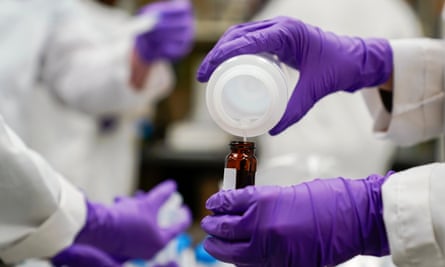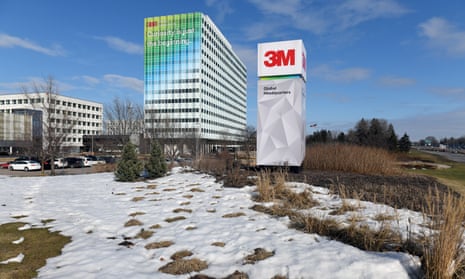When the chemical giant 3M agreed in early June to pay up to $12.5bn to settle a lawsuit over PFAS contamination in water systems across the nation, it was hailed by attorneys as “the largest drinking water settlement in American history”, and viewed as a significant win for the public in the battle against toxic “forever chemicals”.
A second June settlement with the PFAS manufacturers DuPont, Chemours and Corteva tallied a hefty $1.1bn. But while the sums are impressive on their face, they represent just a fraction of the estimated $400bn some estimate will be needed to clean and protect the nation’s drinking water. Orange county, California, alone put the cost of cleaning its system at $1bn.
“While over a billion dollars is real money, it is a virtual drop in the bucket of potential utility costs to monitor, remove and dispose of these contaminants in accordance with anticipated federal regulations,” the American Municipal Water Association trade group said in a statement.
Moreover, the two settlements include just over 6,000 water systems nationwide. Utilities that were not part of the suits but have PFAS in their systems can claim some of the settlement money, or they can sue the chemical manufacturers on their own.
That means the settlements only represent the first wave of utility lawsuits to hit chemical manufacturers, legal observers say. Because PFAS are so widely used and the scale of their harm is so great, chemical makers will get hit from a range of legal angles, and some suspect the industry’s final bill could exceed the $200bn paid by big tobacco in the 1990s.
The number will be “very large”, said Kevin McKie, an attorney with the Environmental Litigation Group who represented a water management company in the 3M case. Though the 3M settlement does not cover all the nation’s costs, it is a strong start, he added.
“‘A good settlement is one where both sides walk away a bit frustrated’ is the old saying,” McKie said. “Of course I would have liked a bit more money but I do believe they got as much as they could at this time, and there’s a lot more to go.”
PFAS are a class of about 15,000 compounds used to make products across dozens of industries resistant to water, stains and heat. They are called “forever chemicals” because they do not naturally break down, and are linked to cancer, kidney disease, liver conditions, immune disorders, birth defects and other health problems.
The chemicals are thought to be contaminating drinking water for over 200 million Americans. Tens of thousands of contaminated private wells are not included in the settlement. The chemicals are also widely used in thousands of consumer products from dental floss to cookware to clothing, and have been found to contaminate food, soil and air.
PFAS constantly cycle and accumulate throughout the environment, and removing them from water is costly. The highly mobile chemicals can slip through most utilities’ filtration systems. Granular activated carbon and reverse osmosis are considered the best options.
Once those systems are in place, they can cost millions more annually to operate than utilities were previously paying. The math leaves utilities with a decision on how to proceed.

Leaders in Stuart, Florida, which was the bellwether case in the 3M settlement, chose to take what they could get without further litigation. Bellwethers are cases that represent all the other plaintiffs in a multi-district lawsuit. Stuart estimated damages at up to $120m, and the city acknowledged the settlement would fall short.
“I don’t think we’ll ever get close to that much net to the city, so I think there is no making us whole,” Stuart’s city manager told the New York Times.
Among those utilities going at it alone is the Cape Fear Public Utility Authority (CFPUA) near Wilmington, North Carolina, which sits on the Cape Fear River about 75 miles downstream from a Chemours PFAS manufacturing plant. It cost the utility about $46m to develop a granular activated carbon system to remove PFAS, and officials estimate an additional $5m in annual operational costs.
The utility declined to comment, citing ongoing litigation, but in a late June op-ed, the CFPUA director Kenneth Waldrop explained the motivation for not joining the settlements: “The information currently available suggests that the proposed settlement, when divided among thousands of other utilities with similar needs, would be insufficient to meet the needs of our community.”
The utility has a “strong case” against Chemours, which has the reserves to cover the full cost, Waldrop added. There is generally support for that approach among Wilmington-area residents, said Emily Donovan, a public health advocate who lives in the region.
“This is not our fault, but it has been made our problem, and the community mostly understands what’s going on,” she said.
The settlements also drew unlikely opponents in 22 state attorneys general who urged the judge to reject the 3M settlement because it “does not adequately account for the pernicious damage that 3M has done in so many of our communities”, said the California attorney general, Rob Bonta.
Beyond water utility settlements, chemical makers face personal injury suits. Most US states will also probably sue over contamination of lakes, rivers and other natural resources. Minnesota alone found eliminating PFAS contamination from its wastewater could run to $28bn.
Local water systems that are not made whole will need help from the federal government, which “basically abandoned public water infrastructure a long time ago”, said Oday Salim, director of the Environmental Law and Sustainability Clinic at the University of Michigan.
“Any amount of money that gets shifted to the victims is helpful,” he added.
The government could implement an excise tax on PFAS to help cover costs, McKie said, and he noted the chemical manufacturers are taking a significant hit. By some estimates, 3M’s PFAS liabilities may soar to as much as $30bn as claims roll in.
“That’s a pretty big chunk of the total size of their corporation,” McKie said.
